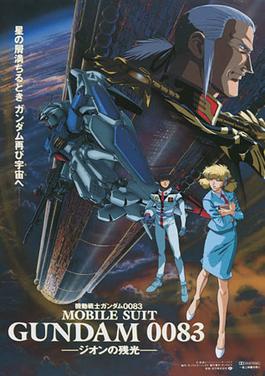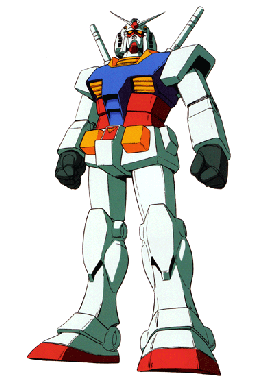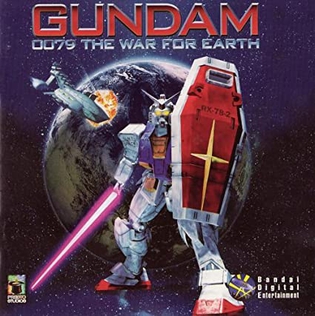
Mobile Suit Gundam, also retrospectively known as First Gundam, Gundam 0079 or simply Gundam '79, is a Japanese anime television series produced Nippon Sunrise. Created and directed by Yoshiyuki Tomino, it premiered in Japan on Nagoya Broadcasting Network and its affiliated ANN stations on April 7, 1979, and lasted until January 26, 1980, spanning 43 episodes. It was the first Gundam series, which has subsequently been adapted into numerous sequels and spin-offs. Set in the futuristic calendar year "Universal Century" 0079, the plot focuses on the war between the Principality of Zeon and the Earth Federation, with the latter unveiling a new giant robot known as the RX-78-2 Gundam piloted by the teenage civilian mechanic Amuro Ray.
Gundam is a Japanese military science fiction media franchise. Created by Yoshiyuki Tomino and Sunrise, the franchise features giant robots, or mecha, with the name "Gundam". The franchise began on April 7, 1979, with Mobile Suit Gundam, a TV series that defined the "real robot" mecha anime genre by featuring giant robots called mobile suits in a militaristic setting. The popularity of the series and its merchandise spawned a franchise that includes 50 TV series, films and OVAs as well as manga, novels and video games, along with a whole industry of plastic model kits known as Gunpla which makes up 90 percent of the Japanese character plastic-model market.

Mobile Suit Gundam: Char's Counterattack is a 1988 Japanese anime science fiction film directed and written by Yoshiyuki Tomino. It is set in the Universal Century timeline of the Gundam franchise. Featuring the talents of Shūichi Ikeda, Toru Furuya, Hirotaka Suzuoki, Maria Kawamura, Nozomu Sasaki, Kōichi Yamadera, among others, it focuses on Char Aznable's attempt of genocide on the planet Earth by pushing the asteroid called Axis into a collision with the planet. As a result, Char's rival from the Earth Federation Amuro Ray tries to defeat him in combat and avoid a slaughter in the process.

Mobile Suit Gundam 0083: Stardust Memory is a 13-episode anime OVA series set in the Gundam universe. The first volume containing two 30-minute episodes was released in Japan on May 23, 1991. Subsequent volumes, containing one 30-minute episode each, followed every one or two months; the final volume went on sale on September 24, 1992. The series was directed by Mitsuko Kase and Takashi Imanishi. A movie compilation, also directed by Imanishi was released in Japan on August 29, 1992, a month before the final OVA volume went on sale. The characters were designed by Toshihiro Kawamoto. Mechanical designs were by Shoji Kawamori and Hajime Katoki.

Mobile Suit Victory Gundam, is a 1993 Japanese science fiction anime television series. It consists of 51 episodes, and was directed by Gundam creator Yoshiyuki Tomino. The series was first broadcast on TV Asahi. It is the fourth TV anime installment in the Gundam franchise, first series in the franchise released in Japan's Heisei period, and the final full series to be set in the Universal Century calendar until Mobile Suit Gundam Gquuuuuux.

Turn A Gundam, also stylized as ∀ Gundam, is a 1999 Japanese mecha anime series produced by Sunrise, and aired between 1999 and 2000 on Fuji Television and other FNS stations. It was created for the Gundam Big Bang 20th Anniversary celebration, and is the eighth installment in the Gundam franchise. It was later compiled in 2002 into two feature-length films entitled Turn A Gundam I: Earth Light and Turn A Gundam II: Moonlight Butterfly.

Mobile Suit Gundam: The 08th MS Team is an original video animation (OVA) anime series in the Gundam franchise. Released from January 25, 1996, to July 25, 1999, the 12-episode series details the exploits of an Earth Federation ground unit during the One Year War—specifically a month after the beginning of the original 1979 Gundam series and into the final weeks of the war.

Mobile Suit Gundam 0080: War in the Pocket is a six episode 1989 Japanese science fiction original video animation series. It is the first OVA series in the Gundam franchise. It was directed by Fumihiko Takayama, written by Hiroyuki Yamaga with character designs by Haruhiko Mikimoto.
The Zaku is a fictional line of "Mobile Suits" or mecha from Mobile Suit Gundam, part of the fictional universe of the Universal Century, where they are the Principality of Zeon's most commonly fielded Mobile Suits. The most widely known model is the MS-06 Zaku II series. It is redesigned by Kunio Okawara based upon the earlier draft by the series director Yoshiyuki Tomino, in which only the name was kept. The Zaku II has seen various redesigns and variants for hundreds of pieces of merchandise, and the Japanese post office has two stamps with Zaku IIs on them. The Zaku's aesthetic can be seen in more symbolic homages in the Gundam mythos, such as the GINN and ZAKU Warrior from Mobile Suit Gundam SEED, the Busshi from Mobile Fighter G Gundam, and the Jenice from After War Gundam X.
The SCV-70 White Base, also nicknamed Trojan Horse, is a fictional spaceship from the Japanese science fiction anime series Mobile Suit Gundam. It serves as the mothership of the protagonist Earth Federation crew members and the famous RX-78-2 Gundam mobile suit. Various spin-offs are designed after it, including a whole class of ships called the Pegasus-class assault carrier, and it has inspired ships in the sequels like the Argama-class in Mobile Suit Zeta Gundam and Archangel-class in Mobile Suit Gundam SEED.

The RX-78-2 Gundam is a fictional manned robot (mecha), introduced in 1979 in Yoshiyuki Tomino's and Sunrise's anime series Mobile Suit Gundam. In the series, it is a prototype weapon for the Earth Federation when it falls into the hands of Amuro Ray, the son of its designer in story, who goes on to pilot it in the Earth Federation's war against the Principality of Zeon.

Gundam Sentinel is a novel set in the Universal Century timeline of the Gundam universe, originally serialized in Model Graphix magazine between September 1987 and August 1988. Gundam Sentinel became a cult hit, due to its super-detailed mechanical designs and an intricate story by veteran writer Masaya Takahashi. Set between the final phase of Mobile Suit Zeta Gundam and the early stages of Gundam ZZ in UC 0088, the story shows the Earth Federation's efforts to stop an insurrection of elite Federation officers.
Gundam Evolve, also known as Mobile Suit Gundam Evolve, is a series of promotional short films set in the different timelines of the Gundam series. Originally there were only five Evolve episodes, produced from 2001 to 2003, Bandai created ten more Evolve episodes from 2004 to 2007. While the first two episodes took place in the Universal Century, some of the later clips also showed Gundams from the other timelines.

Gundam Side Story 0079: Rise From the Ashes is a video game that was released for the Dreamcast. It is based in the Universal Century timeline of the popular Mobile Suit Gundam franchise. It was developed by BEC and published by Bandai. It takes place in Australia, following an elite squad of RGM-79 GMs who are charged with various missions pertaining to the attacks by the Principality of Zeon.

Mobile Suit Gundam: MS Sensen 0079 is a Wii title, published and developed by Namco Bandai, based on Sunrise's Mobile Suit Gundam franchise. Its Japanese release was July 26, 2007.

Gundam 0079: The War for Earth is a video game developed by Presto Studios and published by Bandai Digital Entertainment for Macintosh, Windows, PlayStation, and Apple Bandai Pippin.












